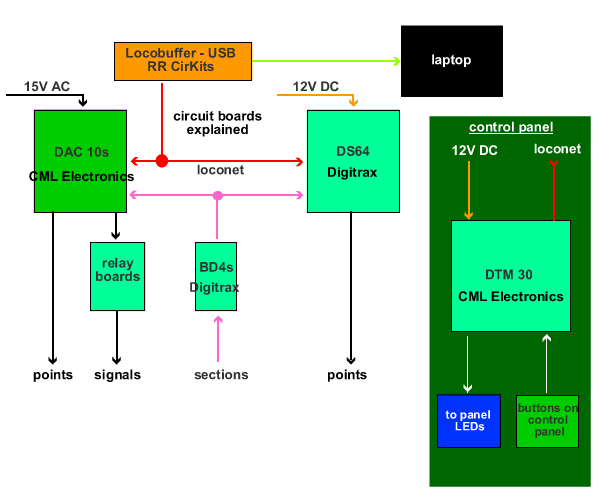|
advanced DCC

I find that operating trains for two whole
days during exhibitions, mind numbingly boring and subject to human error
which quite often results in derailments and wrecks! Our little engines
are very delicate and such treatment was not doing them any good. Our
Desperados have been amazing doing as well as they have and have manually
operated CG far better than I could in a million years but it has been
very hard for them at best.

'mind numbingly boring'
Far better to be able
to talk without distraction to the visitors and even have the time to
visit other stands and spend time talking to old friends. I also quite liked the idea
of just watching trains go by. I therefore decided that the layout would be fitted with
automatic train control so only the port branch coal trains and shunting would be operated by hand.
After further discussions with Malcolm
Alberry, it was decided to go the whole hog. This was a very scary
decision as the equipment is not cheap and I would not have had a chance
of succeeding without Malcolm's help. It must be pointed out that
automatic running is useless unless you have reliable operation. This has
taken a great deal of time but I can now say that we have as close to 100%
train reliability as is possible.
This has been achieved by picking up
current from as many wheels as possible. Our engines are
therefore plugged into 'companion cars' which also pick up current. Many
modifications have also been made to the mechanisms which must travel long
distances without complaint.
I still wished to retain the potential for
manual operation of the layout without depending on electronics. This
means that we have double control panels and it is possible to change from
one system to the other by merely swapping a three plugs.
I shall try to describe how it all works
without the use of too many nerdy terms! Apologies to those who know all
of this stuff!
Apart from just controlling trains, the DCC
system also includes Loconet. Loconet is a system that allows all sorts of
electronics to be daisy chained together with a six wire cable using phone
socket / plugs. Once connected, the various electronic boards are able to 'talk' to
each other. Remember, on a DCC layout, the track remains live with a
special DCC voltage waveform the
whole time. Digital signals are passed down the rails to the locos which
control their operation after they are 'read' by the chip. This is how
loco lights can be switched on and off, and speed and direction control is
effected. Digital signals are also passed down through the Loconet system
and provided the right bits of electronics are provided, the digital
stream can control point, signal and block operations as well as provide
for further train control stations.
Using such systems, the DCC control board is
just fitted with push buttons. The direction of point throws and signal
positions are shown by LEDs.
Sections can be cut into one rail (must be
the same side throughout the layout) and the system can sense where trains
are, which are also shown by LEDs. It is not that dissimilar to full scale
track circuiting. The image below shows how such units fit together
on County Gate.

click on image to enlarge
Parts are Digitrax, supplied by
Sunningwell Command
Control and
CML Electronics

hover over each board for explanation - do
not click All these boards are
multi-functional and some require programming which is rather difficult.
This facility allows us to
control the entire functions of the layout through just one cable (similar
to a telephone cable). The amount of wiring is thus considerably reduced.
Once this is done, by using an interface unit, the
Locobuffer, the
whole network can be connected to a computer, using USB leads. Really complex sequencing of train operation can
then take place. The
whole concept is in effect similar to sequencing and MIDI, for those
familiar with modern musical keyboard systems. The controlling software is
supplied by Railroad &
Co. This is a very flexible system and has an excellent 'help'
forum for the sticky questions. One also has to load a Loconet programme into the
laptop.
Our first show as an
automated railway was at Chatham in June 2009 and I am pleased to be able
to say that the system worked perfectly throughout the weekend. Since that
time, we have displayed the railway fully automated at many more shows
both in the UK and the Continent and have experienced very few problems
indeed.
We do have full wiring
diagrams of County Gate. These are included for our own reference should
problems arise. However, they may give some insight into the work that has
gone into this project.
The software is well explained on
this link
Below is shown a simplified animation of how
the software operates. The route is previously set for Lyn and River Avon.
The red dot shows point motors when activated. After
the railcar and Yeo return to base, Exe and Halliday would be dispatched.
click on image to repeat
A film of the completed
automatic operation can be
seen here

|